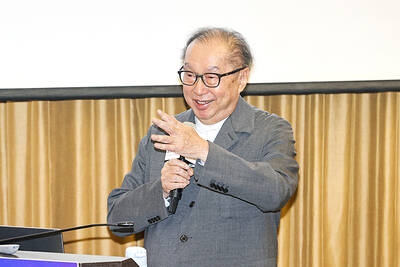About 10 years ago, Stan Shih (施振榮) came across a massage chair made by Osim International Ltd, thinking that it was a high-class product from a Japanese manufacturer.
But the founder of Acer Group was surprised when he found out that Osim was actually a Singaporean brand, during a business trip to the city-state.
Shih, who has an Osim chair at home, has always wondered how the massage chairs from the small city-state were able to beat the Japanese big brands in markets around the globe.
Osim was originally a trading company established in 1980 selling general household items. The company expanded into its first overseas market, Hong Kong, in 1986, a year after its home market in Singapore was hit by a devastating recession.
"The recession taught me two things. One was that the Singaporean market was too small, and we had to expand our external economies," said Ron Sim (沈財福), founder and chief executive of Osim, at a forum in Taipei on Thursday where international and local companies spoke about their brands.
The second lesson Sim learned was that to survive the company had to find a niche -- a key element it lacked being a trading company.
This finally gave birth to the Osim brand in 1993 as the company switched its focus to home healthcare products.
Today, the Singaporean healthcare equipment maker offers more than 100 innovative products in the areas of health, hygiene, nutrition and fitness. Its product portfolios go from massage chairs and air purifiers to health supplements and treadmills.
Osim now operates a wide point-of-sales network with more than 1,100 outlets in more than 28 countries in Asia, Australia, Africa, the Middle East, the UK and North America.
The company has targeted having 3,000 stores around the globe by 2013.
"Brand is a personality. It must be able to speak with substance over time," Sim explained, a lesson Taiwanese tech companies are struggling to learn in order to bring their name to the world's consumers.
He said that the products and shopping experience must be "relevant" to consumers, and Osim launches at least four big new items each year to lure buyers into loosening their purse strings.
One of its products, the iSymphonic -- the industry's first massage chair that synchronizes massage and music -- was voted "Invention of the Year" by Time magazine.
Sim said he had a high respect for Taiwanese entrepreneurship.
"Taiwan is strong in original design manufacturing [ODM] and technologies," but these high-tech firms should always embrace change to hone their competitiveness, he said.
And radical changes are expected to take place at Asustek Computer Inc (
The world's largest motherboard maker is set to spin off its ODM operations from its brand business by the end of the year, moving its original deadline earlier by a year.
"It is inevitable that you see conflicts when a company's own brand gets stronger," Asustek chairman Jonney Shih (
His remarks echo the current predicament for many local tech firms, which will have to find a way to keep their ODM clients happy should they to realize the "brand" dream.
Asustek's portable computers are currently the world's No. 9 brand, which raised some clients' eyebrows. Apple Inc decided to withdraw MacBook orders from Asustek in April.
"It is the right time for the spin off ? Building a brand is no longer a volume or pricing game, it is a mindset involving brand value and product distinctiveness," Shih said.
Despite Asustek's struggle, the government and private sector still hope to nurture more companies and help them become Taiwan's new Asustek or Acer Inc. The "Branding Taiwan Venture Capital" project was launched to help the process last November.
The venture capital fund, which has NT$2 billion, recently shortlisted two companies to be the first recipients of the venture capital.
According to Taiwan External Trade Development Council (

BYPASSING CHINA TARIFFS: In the first five months of this year, Foxconn sent US$4.4bn of iPhones to the US from India, compared with US$3.7bn in the whole of last year Nearly all the iPhones exported by Foxconn Technology Group (富士康科技集團) from India went to the US between March and last month, customs data showed, far above last year’s average of 50 percent and a clear sign of Apple Inc’s efforts to bypass high US tariffs imposed on China. The numbers, being reported by Reuters for the first time, show that Apple has realigned its India exports to almost exclusively serve the US market, when previously the devices were more widely distributed to nations including the Netherlands and the Czech Republic. During March to last month, Foxconn, known as Hon Hai Precision Industry

Taiwan Semiconductor Manufacturing Co (TSMC, 台積電) and the University of Tokyo (UTokyo) yesterday announced the launch of the TSMC-UTokyo Lab to promote advanced semiconductor research, education and talent development. The lab is TSMC’s first laboratory collaboration with a university outside Taiwan, the company said in a statement. The lab would leverage “the extensive knowledge, experience, and creativity” of both institutions, the company said. It is located in the Asano Section of UTokyo’s Hongo, Tokyo, campus and would be managed by UTokyo faculty, guided by directors from UTokyo and TSMC, the company said. TSMC began working with UTokyo in 2019, resulting in 21 research projects,

Ashton Hall’s morning routine involves dunking his head in iced Saratoga Spring Water. For the company that sells the bottled water — Hall’s brand of choice for drinking, brushing his teeth and submerging himself — that is fantastic news. “We’re so thankful to this incredible fitness influencer called Ashton Hall,” Saratoga owner Primo Brands Corp’s CEO Robbert Rietbroek said on an earnings call after Hall’s morning routine video went viral. “He really helped put our brand on the map.” Primo Brands, which was not affiliated with Hall when he made his video, is among the increasing number of companies benefiting from influencer

Quanta Computer Inc (廣達) chairman Barry Lam (林百里) yesterday expressed a downbeat view about the prospects of humanoid robots, given high manufacturing costs and a lack of target customers. Despite rising demand and high expectations for humanoid robots, high research-and-development costs and uncertain profitability remain major concerns, Lam told reporters following the company’s annual shareholders’ meeting in Taoyuan. “Since it seems a bit unworthy to use such high-cost robots to do household chores, I believe robots designed for specific purposes would be more valuable and present a better business opportunity,” Lam said Instead of investing in humanoid robots, Quanta has opted to invest